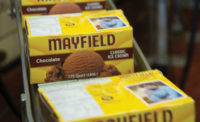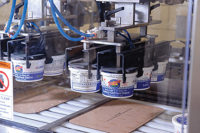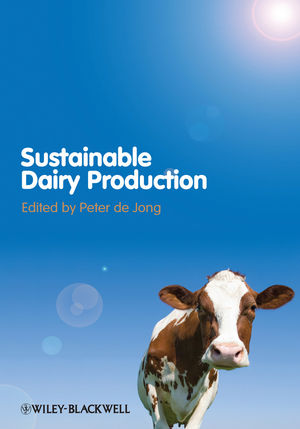Filling New England's dairy needs: Inside Oakhurst's plant
Oakhurst Dairy of Maine processes quality dairy and nondairy beverages and cultured products for its retail, commercial and private-label customers. It also operates a successful sustainability program that reduces energy, water and waste.

The distinctive acorn logo is on the cap of Oakhurst's bottles. The cap also carries the company's pledge to donate 10% of profits "to kids & the environment."
Photos by Vito Palmisano









Ask anyone what they know about Maine and you’ll probably hear “lobster, lighthouses and L.L. Bean.” Milk? Probably not, because Maine isn’t a top dairy state. There are just four milk plants (and eight bulk tank units) in Maine, according to the most recent Interstate Milk Shippers List.
Yet Maine is home to one of the 100 largest dairy processing companies in the United States. Oakhurst Dairy is a third-generation, family-owned business with corporate headquarters and a milk processing plant in Portland. It ranks 84th on the Dairy 100, Dairy Foods’ annual ranking of North America’s largest dairy processors. 2011 sales were $100 million.
The city of Portland grew up around the plant, which was built in 1921. Since then, Oakhurst has renovated and expanded the plant, which is located on a busy street not far from downtown. The plant, at 65,000 square feet (first floor only), is more than three times its original size.
Independent haulers transport milk from 72 independent Maine dairy farms. Milk is balanced with supply from DMS, St. Albans, Vt. The plant on average receives 10 tankers daily, every day of the week.
The receiving area can accommodate two tankers at once, but only one can unload at a time. Oakhurst receives 60,000 to 75,000 gallons a day between 5 a.m. and 5 p.m. The plant processes milk five days a week; the additional milk is stored in silos. Oakhurst has four raw-milk silos, each holding 40,000 gallons. There is also one innovative vertical dual-tank 10,000-gallon silo for liquid sugar (Oakhurst no longer uses high-fructose corn syrup) and one 5,000-gallon silo for orange juice concentrate.
A small lab in the receiving area performs testing on raw milk. An upstairs laboratory, certified by the state of Maine, runs tests on raw, in-process and finished products. In addition to full organoleptic sampling, tests include checks for coliform, SPC, SCC, freezing point, antibiotics and milk composition. Finished product, with a shelf life of 18 to 21 days, is also tested. Oakhurst is Level 3 SQF-certified and received an audit score of 98%. Oakhurst Dairy is also HACCP-certified.
Processing and formats
The plant has 13 horizontal and vertical pasteurization or finished-product tanks with a capacity of 147,000 gallons of pasteurized products.
In the pasteurization room, which looks onto Forest Avenue, are two high-temperature/short-time pasteurization units and two homogenization units. HTST unit No. 1 has a capacity of 3,300 gallons per hour and HTST unit No. 2 can pasteurize 7,800 gallons per hour.
There are batch tanks used for flavored-dairy product (including egg nog and chocolate milk) and nondairy beverages (including teas and orange juice). A liquefier is used for products requiring the addition of powdered ingredients. Oakhurst uses Dutch chocolate in its premium chocolate milk. A 500-gallon tank can store cream for a short period of time.
The plant has seven filling lines for paper cartons and blow-molded plastic bottles. Plastic bottles are blow-molded by Consolidated Container Corp., which has a plant in an adjoining building. The bottles are labeled and code-dated with low-solvent adhesives and inks by Oakhurst in an upstairs room and are conveyed to the filling floor below. Oakhurst uses one or two labels, depending on the SKU. The front label allows Oakhurst to display its brand prominently. The back label contains the nutrition information. (Certain store-brand products have one label.) Oakhurst products are labeled “guaranteed fresh.” Other products have a “best by” date.
Two-thirds of Oakhurst’s milk is bottled in gallon containers. The gallon filler has 30 valves and can process 103 units a minute. A second filler, with a capacity of 340 units a minute, fills 4-ounce and 8-ounce paper containers for the school and hospital markets.
A 36-valve filler handles 165 10-ounce containers a minute, while a 21-valve machine runs at 150 pint containers per minute. These two lines package milks, juices, teas and lemonade. A 26-valve filler has an output of 125 half-gallon bottles a minute. Another 21-valve quart machine produces 85 quarts per minute.
When changeovers occur, Oakhurst uses water treated by a UV light system. Although the city water is of good quality, the UV system is an extra check to reduce microbials.
Fat-free half & half, bottled in pint and quart packages, was introduced in 2012. So was Chocolate Nog, a combination of super-premium chocolate milk and egg nog. It’s filled in pints and quarts. For 2013, the company is focusing on chocolate milk (as the beverage is gaining acceptance as a post-workout beverage) and developing its iced tea and lemonade line extensions.
In a separate room, a bag-in-box filler packages 5-gallon and 2½ -gallon bags for the foodservice market and for distributors. It also bags ice cream mix, a seasonal product with demand from March to October. Oakhurst packages plain, vanilla and chocolate ice cream mixes containing several different butterfat levels. Currently Oakhurst produces a soft-serve 5% mix in vanilla and chocolate and a hard-serve plain mix in both 14% and 16%. This year, Oakhurst plans to increase awareness of its ice cream business to drive trial and to increase market share, said co-president John H. Bennett.
Oakhurst also makes and packages cultured products in an area next to the pasteurization room on Forest Avenue. There are 800-gallon and 500-gallon culture tanks used in the production of sour cream and buttermilk.
About 60% of production is for Oakhurst brands. The remaining is for private-label and co-pack accounts. Oakhurst processes soy beverages for a retail customer. Oakhurst -branded UHT creamers and whipped cream are co-packed.
Warehousing
Oakhurst uses two multilevel coolers located on opposite sides of its plant. The first was built in 1989 after a period of major expansion and the second built in 2005. Both employ advanced warehouse management and load selection technology. Together these two warehouses provide the storage and loading capacity for Oakhurst’s customer base, depots and for future growth.
Oakhurst has a strong DSD business. So in addition to storing the products it processes on site, Oakhurst also warehouses sandwiches, whipping cream, prepared foods and other items. To better manage the DSD business and serve those customers, Oakhurst made a major
investment in information technology. A proprietary system called Vision combines off-the-shelf software with custom, internally developed programs. Previously, all data were housed with an outside service.
Sustainability
Oakhurst Dairy received an honorable mention from the Innovation Center for U.S. Dairy in its inaugural sustainability awards program in 2012. Oakhurst’s efforts to reduce its energy and water use actually started more than 20 years ago. It formalized its efforts by creating a corporate sustainability committee. In 2010, Oakhurst set a new goal: to reduce water use, plant energy use, greenhouse gas (GHG) emissions, transportation fuel use and solid waste by 20% by 2014 (compared to a 2008 baseline). To date the company has made steady progress towards these goals in all categories with the GHG goal actually having been fully attained.
By automating drink and juice batching, as well as production line start-up and shut-down procedures, Oakhurst saves over 2.1 million gallons of water annually. New technology is currently being reviewed to determine what processes will need to be modified in the future to continue to reduce water usage.
Investments in energy improvement in the plant include new insulation for the refrigeration system, T-8 high-efficiency lighting and a variable-speed compressor. An array of rooftop solar photovoltaic panels provides 15% of the energy load at an Oakhurst refrigerated depot facility. Seventy-two thermal hot water solar panels on the roof of its headquarters in Portland, combined with Oakhurst’s innovative hot water recovery system, save the company more than 7,500 gallons of heating oil a year.
Chairman Bill Bennett and co-president John Bennett’s grandfather delivered dairy products in two horse-drawn milk wagons in 1921. Today, the company uses hybrid and biodiesel-fuel vehicles to deliver its products. The company buys biodiesel fuel from Maine Standard Biofuels, which recycles more than 150,000 gallons of used cooking oil from restaurants and food manufacturers. Biodiesel meets about 26% of the overall fuel needs.
To reduce the energy used in transportation, in 2005 Oakhurst began using re-routing software. Implemented three times a year, the re-routing process results in a dramatic reduction of miles driven and thus fuel consumed. Also in 2005, the dairy started to convert its auto fleet to hybrid vehicles; today half of the fleet are hybrids. The company also operates four hybrid delivery trucks. Three of these trucks deliver in communities in New Hampshire that do not meet air-quality standards. The trucks were funded with a grant from the New Hampshire Department of Environmental Services. Side-panel skirts on 35 semi-tractor trailers were installed to increase fuel efficiency from 6% to 8% per truck.
A company to watch
Just about every food company nowadays finds a way to market itself as a small-batch, down-home source of wholesome foods. To some extent, Oakhurst does that with its tagline, “The Natural Goodness of Maine.” But behind the folksy slogan is a highly sophisticated company that is a leader in dairy processing sustainability. It’s a model company in New England for green programs and an example that dairy processors across the country would be wise to follow.
Oakhurst’s Dairy Production
• Milk (whole, 2%, 1.5%, 1%, skim)
• Value-added milk (Nu-trish, Omega-3)
• Flavored milk (chocolate, strawberry, coffee)
• Egg nog (light, regular and chocolate)
• Buttermilk
• Coffee creams (half & half and fat-free half & half)
• Cooking creams (light, heavy, whipping)
• Sour cream
• Cottage cheese
Formats include 4-ounce, half-pints, 10-ounce, pints, quarts, half-gallons and gallons.
Oakhurst’s Nondairy Production
• Orange juice
• Cranberry juice cocktail
• Apple juice
• Lemonade
• Raspberry lemonade
• Ice tea with lemon
• Iced tea and lemonade
• Raspberry iced tea
• Pomegranate iced tea
• Blueberry iced tea
• Green tea with honey and ginseng
• Wild Berry flavored drink
• Fruit drink
• Orange drink
• Lemon drink
• Soy-based Cappuccinos (double mocha, French vanilla) flavored beverages
Formats are 4-ounce, 8-ounce, pints, quarts and half-gallons
At A Glance
Oakhurst Dairy Interstate Milk Shippers Plant 23-01, Portland, Maine
Year built: 1921. Major renovation in 1954. Renovation and addition of cooler in 1989; subsequent addition of receiving bays and cooler.
Size of plant: 65,000 square feet (first floor space).
Employees: 173 full- and part-time. Two production shifts on five days. There are also 37 drivers who work at one of three depots or two transfer stations.
Products: Milk, flavored milk, buttermilk, egg nog, coffee creams, cooking creams, iced tea, lemonade, fruit drink, orange juice, apple juice, cranberry juice cocktail.
Silos: Four raw milk (total capacity of 160,000 gallons), 13 pasteurized/finished product (150,000 gallons), plus storage for cream (11,600 gallons), orange juice concentrate (5,000 gallons) and liquid sugar (10,000 gallons).
Pasteurization: High-temperature/short-time. One 7,800-gallons-per-hour unit; one 3,300 gph unit.
Fillers: Seven.
Looking for a reprint of this article?
From high-res PDFs to custom plaques, order your copy today!














